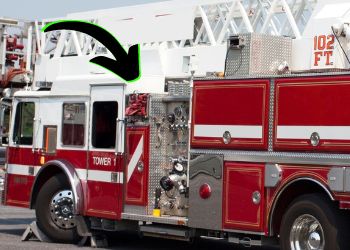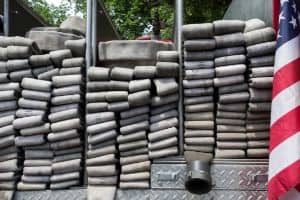When preparing a fire engine for transportation out to the source of a fire, lots of equipment must be packed in there, including the fire hose. That usually requires a configuration for organizing the hose such as a cross-lay. What is a cross-lay?

A cross-lay is a means of storing a fire hose so the hose can be quickly deployed. The hose is stored perpendicular to the pump panel.
In today’s article, we’ll talk further about the history of the cross-lay, what it is, how to use it, and the variations on it. New firefighters especially will not want to miss this one!
Table of Contents
What Is a Cross-Lay?
The cross-lay is more commonly referred to as the Mattydale lay but it’s also sometimes called the transverse lay or the speedlay.
As you’ll recall from the intro, when storing hose on a fire engine, the fire department needs to think about the practicality of the hose positioning (such as easy access) as well as where the hose will go on the fire engine.
The cross-lay method is designed for situations in which a firefighter will very quickly have to deploy a hose line to immediately combat a fire.
As part of a cross-lay setup, a fire engine will usually have a hose load. The fire hose will be connected to the hose load, but only a prescribed amount of the hose.
Some firefighters might opt to use a fire hose vacuum to pull out the air from the interior of the hose. It’s then easier to place the hose in a hose bed or compartment. The nozzle should be easily reached from the fire engine exterior.
It’s also recommended to use a female coupling pre-connect to increase the discharge speed.
Then, to do a cross-lay, you’d put the fire hose perpendicular over the pump panel (or at least adjacent to it).
The History of the Cross-Lay
So why is the cross-lay more commonly referred to as the Mattydale lay?
It’s named after Mattydale, New York, the birthplace of the cross-lay.
The cross-lay is credited to Chief Burton L. Eno, who created the setup in 1947. Eno led the fire department in Mattydale with his new cross-lay.
After his fire department realized the value of his invention, the cross-lay was built on on a 1939 Buffalo Fire Appliance Corp. Pathfinder fire engine, the first to ever have a cross-lay.
Variations of the Cross-Lay
As with every new creation, once it’s out, there are always variations and improvements made. Let’s take a look at the various cross-lay variations now.
Triple-Layer Load
The triple-layer load is sometimes called the S-load due to the way the fire hose looks on the engine.
The fire department would take the hose and fold it three separate times and then load it onto the fire engine.
If a fire department has to combat a blaze in a tight area, the triple-layer load is very good for that. It’s also handy when deploying fire line fast.

The S-shape keeps the fire line more organized than perhaps even the cross-lay or Mattydale lay method.
Minuteman Load
The next cross-lay variation is known as the minuteman load. This is a rather specialty setup that not every fire department would use or all that often.
Essentially, the fire department takes a significant portion of the fire hose and places it on their shoulders. Then they’d drop it off, which is known as paying out.
The fire hose is not simply dropped randomly on the ground though but is instead positioned in such a way that it’s nearer to the fire. This way, a firefighter can quickly pick up the line and begin staunching the fire.
Horseshoe Load
The horseshoe load is another interesting take on the Mattydale lay. The load is folded entirely in half so it makes the shape of a horseshoe. The reverse horseshoe is a take on the horseshoe load.
Flat Load
With a flat load, a firefighter takes a flat fire hose and then stacks it on a track. It’s easier to deploy the fire hose when the fire department arrives at the scene.
Further, the convenience of repacking that a flat load allows for has made this a popular option for fire departments.
Accordion Load
The last type of cross-lay variation is the accordion load. The load of the flat hose in this style allows the hose to stand on its ends as an accordion would. However, the load is left like that rather than folded.
A cross-lay or a Mattydale lay is a means of laying a fire hose on a fire engine to deploy it easily at the scene of a fire.
Created in the late 1940s, the cross-lay gave way to variations that use different hose loads or how the hose is folded and stored in the lay. They include the triple-layer, minuteman, horseshoe, flat, and accordion loads.
If your fire department favors the cross-lay method, we hope this article gave you new knowledge and appreciation of the Mattydale lay!